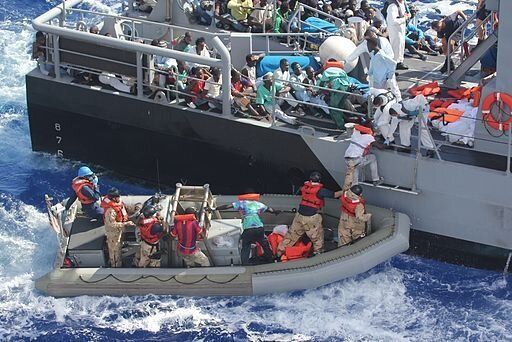
*Fabrice Langrognet [2014] is a PhD candidate in History at St. John's college and the president of the Cambridge Migration Society. For four years he was a judge in the administrative branch of the French judiciary, specialising in immigration and asylum cases. Picture credit: Distressed migrants are transferred from the amphibious transport dock ship USS San Antonio (LPD 17) to Armed Forces of Malta offshore patrol vessel P52 in the Mediterranean. Official U.S. Navy Page from United States of America U.S. Navy photo/U.S. Navy [Public domain], via Wikimedia Commons.
Migrants have been drowning long before European political leaders suddenly decided, on the morning of April 20, 2015, that 800 deaths at a time were somehow above the threshold of tolerable outrage.
Boat-people fleeing turmoil in Vietnam, Laos and Cambodia between the late 1970s and early 1990s died, according to the most conservative estimates, by the hundreds of thousands. The Australian border deaths database records hundreds of deadly shipwrecks as desperate people try to reach the island continent, fleeing from war and persecution in East Timor, Sri Lanka Afghanistan or Burma. The odyssey of the Rohingyas, currently adrift in the Andaman Sea, provides a vivid reminder. People fishing off the windy beaches of Nouadhibou, captains of cargo-ships crossing the Bab el-Mandeb strait and local residents living along the Yalu, the Maritsa or the Rio Grande all have plenty of stories to tell about those swollen corpses that surface with scary regularity before their eyes. But international waters are far from being the only cemetery of migrants; deserts, forests, tractor-trailer trucks, police stations and detention facilities are also high-up on the macabre list of migrants' final resting places.
In the Mediterranean, statistics from the United Nations High Commissioner for Refugees (UNHCR) indicate that every two hours one person has died since the beginning of 2015, trying to reach Italy, Greece or Malta. This dreadful surge in casualties compared to previous years is congruent with a rise in overall numbers of crossings: between 2012 and 2014, the number of individuals who crossed the "white inland sea", as the great historian Fernand Braudel used to call this seemingly tame, yet extremely dangerous water mass, skyrocketed from 20,000 to 200,000.
The good news is that when you start doing something about an unprecedented humanitarian peril, you can break records for humanitarian efficiency. The Italian Navy managed to rescue at least 150,000 people in a single year between October 2013 and November 2014, through an impressively determined, if largely improvised, operational effort. The Italian Republic, a country riddled with no less short-sighted populism and economically-flawed anti-immigrant rhetoric than its neighbours, single-handedly decided to live up to its founding values by not letting any asylum-seeker die at sea, even far off its own waters.
Unfortunately, when Rome asked Europe to share the monthly nine million euro bill, its EU partners sternly declined to contribute. Which of us would not have agreed to crowdfund, with 27 friends, a monthly sum equivalent to the yearly Civil List of the British Royal family, if the goal was to save, in a single year, a number of people larger than the entire population of Cambridge?
To be fair, a minimal consensus was eventually reached amongst EU Member States and a multilateral operation was indeed put in place in late 2014. Less ambitious in scope, insufficiently funded, surveillance- instead of rescue-based, it proved a major political mistake and a most unfortunate humanitarian failure. Hence the new proposal, hastily devised by the European Commission and presented on May 13, 2015, to dramatically expand the objectives and resources of the current operation and distribute the burden of hosting the asylum-seekers among all Member States.
A human-rights driven solution
It is sheer hypocrisy to pretend that rescuing people at sea will increase the comparative appeal of such a deadly route. Police brutality against migrants sitting on the ever higher fences of Ceuta and Melilla, Frontex thermal detections in Bulgaria, Romania and Poland, the pursuit of the practice initiated in the early 1990s in which scores of people can be, after a hurried interview in airports' international zones, denied the right to claim asylum on EU soil in violation of the fundamental principle of "non-refoulement": all of these factors have to be taken into account to understand the attractiveness of trying one's luck via the maritime route. In addition, of course, to the growing skills and declining fares of smuggling cartels operating in Libya, which are specifically targetted by the new security operation agreed upon by the EU Member States on May 18.
Assuming that European leaders, and hopefully their African counterparts who have kept a deafening silence so far, will collectively find a way to halt the Mediterranean hecatomb for a while, asylum and immigration law will need to be properly harmonised at EU-level. Otherwise imbalances will continue to massively affect the migration patterns and routes that people are inclined to privilege: in 2013, for example, one in two asylum-seekers were granted a residence permit in Sweden - nine in 10 for Syrians, compared to just one in five in France. Anything short of a permanent, comprehensive, fact-based and human-rights driven set of solutions regarding both legal and undocumented immigration to the EU, embedded in a profound overhaul of the EU's relations with its poorer neighbours, will fail to stop the migrants from spending all their savings, putting their lives at risk, and eventually dying at sea.
